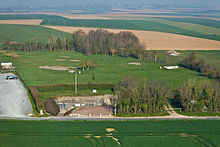Resistance nest 17
| Resistance nest 17 | ||
|---|---|---|
|
View of a reconstructed bunker entrance |
||
| Alternative name (s): |
Hillman site (English) site Hillman (French) |
|
| Creation time : | 1942-1944 | |
| Castle type : | bunker | |
| Place: | Colleville-Montgomery | |
| Geographical location | 49 ° 15 ′ 55 ″ N , 0 ° 18 ′ 37 ″ W | |
|
|
||
The Resistance Nest 17 (allied code name Hillman site ) is a German command post built during World War II in the community of Colleville-Montgomery in Normandy .
presentation
From 1942 the Germans built a fortified position with 18 underground bunkers on a 24 hectare site (width 600 m, length 400 m) south of the community of Colleville-Montgomery (then Colleville-sur-Orne) . The name "Hillman" is based on an alias given by the English for the landing of the Allied troops .
description
It was the headquarters of the coastal defense commanded by Colonel Krug, to which 150 soldiers of the 736th Grenadier Regiment were assigned. The bunkers had armor 20 to 30 cm thick at the top and were equipped with machine guns. They were also fitted with a mechanical ventilation system. There was an elaborate network of galleries and ditches between the various underground positions, which contained the guards, the transmission point, the dining room and the sleeping quarters. All fortified positions were connected by telephone lines dug 2 to 3 m deep.
The strategic position of the entire position was favorable: from here it was possible to reach not only the stretch of coast where the Allied landings were expected, but also Saint-Aubin-d'Arquenay and the area beyond Ouistreham and the Orne . The range of the guns was 600 m and more in all directions.
Hillman was a fortress that can be compared to parts of the Maginot Line .
D-Day
The 1st Battalion of the Suffolk Regiment fell on D-Day to storm this fortification, which they succeeded on the morning of June 7th. The British General Staff had greatly underestimated the defense capabilities of the Hillman bunkers.
Today some historians believe that the strong resistance of the Hillman Bunker was one of the reasons that prevented the British 3rd Infantry Division from taking Caen on the evening of June 6th.
Post-war years
In the post-war years, the underground facilities were gradually filled with earth and rubble, which is why they have been preserved in good condition.
For several years now, an association in Colleville-Montgomery has made it its mission to uncover the fortifications as a testimony to the history of their community.
See also
Web links
Individual evidence
- ^ Result of 25 years of recovery on YouTube , retrieved from the invalid format .



